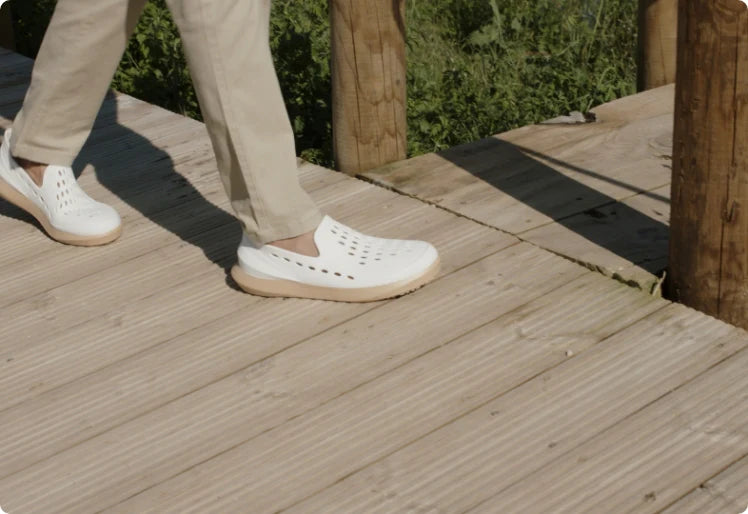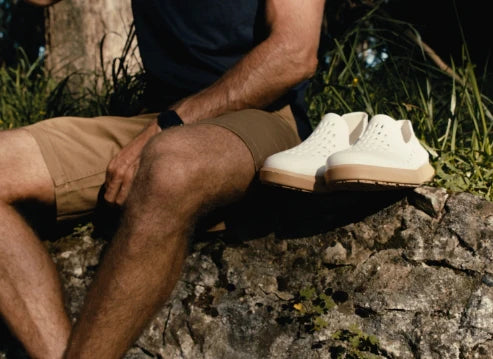Recovery shoes are a specialized type of footwear designed to support runners during their post-workout recovery phase. These shoes prioritize comfort, cushioning, and support to help your feet and muscles recover after intense training sessions.
The importance of recovery in a runner's routine can't be understated. Your body needs time to repair and strengthen between workouts, making proper recovery essential for:
- Preventing injuries
- Reducing muscle fatigue
- Enhancing performance
- Maintaining long-term running health
Many runners invest in technical running shoes, compression gear, and recovery tools - but what about dedicated recovery footwear? This article explores whether recovery shoes are a necessary addition to your running gear. You'll discover their unique features, benefits, and how they differ from regular running shoes. We'll also help you determine if recovery shoes align with your running goals and recovery needs.
Understanding Recovery Shoes
Recovery shoes are a specific type of footwear designed to support your feet during the important recovery period after running. Unlike regular running shoes that focus on performance, recovery shoes prioritize comfort and healing.
Key Features That Define Recovery Shoes:
- Enhanced Cushioning Technology - Recovery shoes have thick, soft midsoles that provide extra cushioning and reduce impact forces while walking.
- Strategic Shock Absorption - Special materials in the heel and forefoot areas help absorb any remaining stress from running.
- Anatomical Support Structure - Built-in arch support and heel cups ensure proper foot positioning during recovery.
The design of recovery shoes aims to improve blood circulation and relax muscles. The spacious toe area allows your feet to spread naturally, while the flexible materials accommodate any swelling that may occur after intense training sessions.
These shoes work by redistributing pressure points across your feet, creating an environment that promotes natural healing. The combination of cushioning and support helps maintain proper foot alignment, reducing strain on tired muscles and tendons.
For runners who log high mileage, recovery shoes can be a valuable tool in preventing common issues like plantar fasciitis and Achilles tendonitis. The structured support system helps maintain optimal foot mechanics even when your muscles are fatigued from training.
Benefits of Wearing Recovery Shoes After Running
Recovery shoes offer significant benefits for runners looking to improve their recovery after a run. Here's what you can gain by adding these specialized shoes to your routine:
- Faster Recovery
The cushioning technology in recovery shoes helps reduce the impact on tired muscles
Wearing recovery shoes promotes better blood circulation in your feet and legs
With less stress on your foot structures, your body can start the healing process more quickly
- Less Muscle Soreness
Recovery shoes help minimize inflammation in the tissues of your feet after a run
The supportive design of these shoes can prevent delayed onset muscle soreness (DOMS)
By reducing muscle soreness, you'll be able to stick to your training schedule more consistently
- Injury Prevention and Management
If you have plantar fasciitis, wearing recovery shoes with proper arch support can help alleviate symptoms
Achilles tendonitis recovery can be sped up by reducing strain on the tendon through these shoes
The shock-absorbing features of recovery shoes can lower the risk of developing shin splints
- Long-Term Foot Health Benefits
Enhanced arch support from recovery shoes can prevent your arches from collapsing during long runs
Proper alignment provided by these shoes can reduce stress on your joints and ligaments
Regular use of recovery shoes may lead to fewer overuse injuries for distance runners
Your feet experience a lot of impact while running - up to three times your body weight with each step. Recovery shoes create an ideal environment for healing by redistributing pressure points and supporting the natural mechanics of your feet. This specialized support system allows you to recover faster between training sessions and protects against common running injuries.
The combination of cushioning, support, and pressure redistribution makes recovery shoes especially beneficial for runners who log high weekly mileage or train for endurance events. These shoes actively promote healing while you focus on other parts of your recovery routine.
The Psychological Edge: Mental Recovery Through Footwear Comfort
Mental recovery is crucial for athletic performance, but it's often overlooked in favor of physical recovery methods. Recovery shoes bring about a mental shift that signals to your brain it's time to relax and recover after intense training sessions.
The simple act of changing into comfortable recovery footwear triggers a mental transition from "performance mode" to "recovery mode." This ritual helps athletes:
- Release mental tension accumulated during training
- Create clear boundaries between workout and recovery periods
- Establish positive recovery habits
- Build confidence in their recovery process
The Link Between Comfort and Well-Being
Research suggests that physical comfort directly influences psychological well-being. When you slip into recovery shoes, the plush cushioning and supportive design create immediate comfort sensations that help:
- Reduce stress levels
- Improve mood
- Enhance relaxation
- Promote mental refreshment
Athletes who prioritize both physical and mental recovery through dedicated recovery footwear report:
"The moment I put on my recovery shoes, my mind starts to unwind. It's like giving myself permission to fully embrace the recovery process" - Elite marathon runner
This psychological benefit extends beyond elite athletes. Regular runners find that designated recovery footwear helps them maintain a healthy balance between training intensity and necessary rest periods, creating a sustainable approach to their running practice.
Exploring Different Types Of Recovery Footwear For Runners' Needs
Recovery footwear comes in two main categories: slide-on sandals and closed-toe shoes. Each type serves specific recovery needs and preferences for runners at different stages of their recovery journey.
- Slide-On Sandals
- Quick and easy to put on after races or training sessions
- Maximum breathability for hot, swollen feet
- Lightweight design reduces strain on tired leg muscles
- Open-toe design allows toes to spread naturally
- Perfect for immediate post-run recovery
- Closed-Toe Recovery Shoes
- Full foot protection for everyday wear
- Enhanced stability for longer recovery periods
- Better support for prolonged standing or walking
- Suitable for various weather conditions
- Ideal for runners with specific foot conditions
Eco-Friendly Options For Environmentally Conscious Runners
The running community's growing environmental awareness has sparked a revolution in sustainable recovery footwear. Many brands now incorporate eco-friendly materials without compromising comfort or functionality.
Sustainable Materials Used in Modern Recovery Shoes:
- Recycled EVA foam - Creates cushioned midsoles from repurposed materials
- Natural rubber - Provides durable, biodegradable outsoles
- Cork footbeds - Offers renewable, antimicrobial support
Recycled plastic uppers - Transforms ocean waste into breathable shoe materials
Hemp fabric - Delivers sustainable durability and natural moisture-wicking
Popular sustainable recovery shoe features include:
- Zero-waste manufacturing processes
- Biodegradable components
- Recyclable packaging
- Water-based adhesives
- Chemical-free dyes
Leading brands have developed innovative approaches to sustainable recovery footwear:
- Plant-based foam technologies
- Algae-based cushioning systems
- Renewable resource materials
- Carbon-neutral production methods
These eco-friendly options prove you don't need to choose between environmental responsibility and effective recovery. The sustainable materials often provide additional benefits like improved breathability and natural antimicrobial properties, enhancing the recovery experience while reducing environmental impact.
Moreover, when considering the choice between different styles of recovery footwear, it's worth noting that slip-on shoes can offer unparalleled convenience due to their ease of use. They allow wearers to effortlessly slide them on and off without the hassle of laces, making them an excellent option for immediate post-run recovery.
Key Characteristics To Look For When Choosing Your Ideal Pair Of Recovery Shoes As A Runner
Selecting the right recovery shoes requires understanding specific features that set them apart from regular running footwear. Here are the essential characteristics you need to consider:
- Plush Footbed Construction
- Deep cushioning with memory foam or similar responsive materials
- Anatomically designed footbed that cradles your foot's natural shape
- Pressure-point relief zones in high-impact areas
- Multi-layer cushioning system for enhanced comfort
- Durable Outsole Design
- Non-marking rubber compounds for indoor-outdoor versatility
- Strategic grip patterns for stable walking
- Wear-resistant materials that maintain shape through extended use
- Flexible zones that support natural foot movement
Running Shoes vs Recovery Shoes: Key Differences
Regular running shoes focus on performance metrics, while recovery shoes prioritize healing and comfort. Here's what sets them apart:
Running Shoes
- Responsive cushioning for energy return
- Structured support for forward momentum
- Performance-oriented fit for speed
- Designed for impact absorption during active movement
Recovery Shoes
- Soft, forgiving materials that reduce muscle strain
- Wider toe box to allow natural foot spreading
- Zero-drop or minimal drop design for natural positioning
- Built-in arch support without restricting movement
- Material Selection
Your recovery shoes should feel noticeably different from your running shoes. The sensation of stepping into them signals to your body that it's time to recover. Look for shoes that provide immediate comfort without requiring a break-in period.
For those who also work long hours on their feet, finding the best shoes for 12-hour shifts can be equally important. These shoes not only ensure comfort and support but also significantly impact overall health and job performance.
Fit Considerations
- Choose a size that allows slight movement without slipping
- Consider going up half a size to accommodate post-run foot swelling
- Test the shoes during evening hours when feet are naturally larger
- Ensure adequate width to prevent pressure points
The right recovery shoes complement your running routine by providing a distinct experience focused on restoration rather than performance. These shoes serve as a valuable tool in your training arsenal, helping your feet and legs prepare for the next run.
Additionally, if you're considering using hiking shoes for walking, it's worth noting that comfortable and supportive footwear is crucial whether you're strolling through city streets or embarking on a nature trail.
Who Can Benefit From Using Recovery Shoes? Exploring The Target Audience Beyond Just Elite Athletes
Recovery shoes aren't exclusive to professional athletes - they serve a diverse range of individuals seeking foot comfort and recovery benefits:
Elite Athletes: Marathon runners, triathletes, and competitive sports professionals use recovery shoes as part of their training regimen
Recreational Runners: Weekend warriors and casual joggers can benefit from enhanced recovery between running sessions
Fitness Enthusiasts: Gym-goers and cross-training enthusiasts find relief in recovery shoes after intense workouts
Active Professionals: Teachers, healthcare workers, and service industry professionals who spend long hours on their feet
Injury Recovery: Individuals managing foot-related conditions or recovering from injuries benefit from the supportive features
Senior Athletes: Older runners and active seniors appreciate the extra cushioning and support for joint health
Recovery shoes serve anyone prioritizing foot health and comfort. The specialized design features benefit both high-performance athletes and health-conscious individuals looking to maintain an active lifestyle. Users report improved comfort levels during recovery periods and enhanced ability to maintain consistent training schedules.
How To Choose Appropriate Pair Of Recovery Footwear That Suits You Best As A Runner?
Selecting the right recovery shoes requires careful consideration of several key factors to maximize your post-run recovery benefits:
Fit and Comfort
- Try shoes at the end of your day when feet are slightly swollen
- Ensure adequate toe room (about thumb's width)
- Choose breathable materials for extended wear
Support Features
- Match arch support to your foot type
- Look for deep heel cups to stabilize feet
- Check for adequate cushioning in high-impact areas
Practical Considerations
- Select easy-to-wear styles for quick transitions
- Consider your climate and typical usage patterns
- Evaluate durability of materials and construction
Personal Preferences
- Test different closure systems (slip-on vs adjustable)
- Consider indoor/outdoor versatility
- Factor in your budget and expected lifespan
Your recovery shoes should feel immediately comfortable without requiring a "breaking in" period. The best pair will complement your running routine and encourage consistent use during recovery phases.




